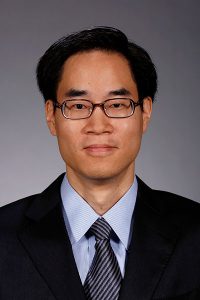 New AerE assistant professor pushes for engaged education and student growth
New AerE assistant professor pushes for engaged education and student growth
As a graduate student TA for an introductory engineering class at Purdue University, Benjamin Ahn observed something about the way students learn technical information through a bit of an informal experiment. The new assistant professor in AerE was teaching two classes, one in the morning and one in the afternoon. In the morning, he lectured and gave the information to the students cut and dry, but in the afternoon session, Ahn worked in examples of applications from the research he was doing for his graduate studies or from another field application.
He noticed the students in his second class were invariably more engaged and willing to learn. They asked more questions and spent additional time solving the problems. It was this experience that sparked Ahn’s interest in engineering education.
Ahn began his higher education in Australia at the University of New South Wales, where he received his B.E. in aerospace engineering. He then moved to Purdue University to earn his M.S. in aeronautics and astronautics engineering and his Ph.D. in engineering education. Following his time at Purdue, he worked as a post-doc for a year with the Massachusetts Institute of Technology. Through MIT’s collaboration with Singapore University of Technology and Design (SUTD), Ahn designed a leadership program for MIT and SUTD students as well as assessed design and cross-culture collaboration courses at MIT.
Now at Iowa State, Ahn has two main areas of research: implementing instructional innovation in engineering classrooms and developing professional skills for engineering students. For the first area, Ahn is building on his studies from grad school to work on ways to make students more engaged in class. He works on integrating new experiences into the curriculum, such as student-centered pedagogy, undergraduate research experiences, and online learning components.
Ahn feels the push to increase engagement in the classes he currently instructs. “Right now I’m teaching an engineering mechanics class that has large sections with between 60 and 80 students,” he says. “While I don’t think we should completely remove the lecture portion, I think there is a way we could have students more engaged and really help them understand how what they’re learning applies in the field.”
This engagement is something Ahn is especially looking to spark in the minds of underrepresented engineering populations, namely female engineers and minority groups. He is looking for recruitment, retention, and successful graduation of underrepresented students to be a priority.
The second area of his work involves professional development for students. “Of course we want our engineers to be technically competent,” Ahn says, “but we also want the students to be well-rounded.” Ahn wants students to develop leadership, communication, teamwork and ethical reasoning skills, all of which he is working to emphasize in the undergraduate program. He adds that industry is demanding these kinds of skills from students.
Ahn is hoping that helping students to gain these skills will improve their future in the field. “Working closely with ISU students and faculty, I want to develop research evidence-based courses, interventions, and assessments to enhance engineering education experiences for ISU students. By transforming my engineering education research into practice, I want to educate future engineering leaders.”